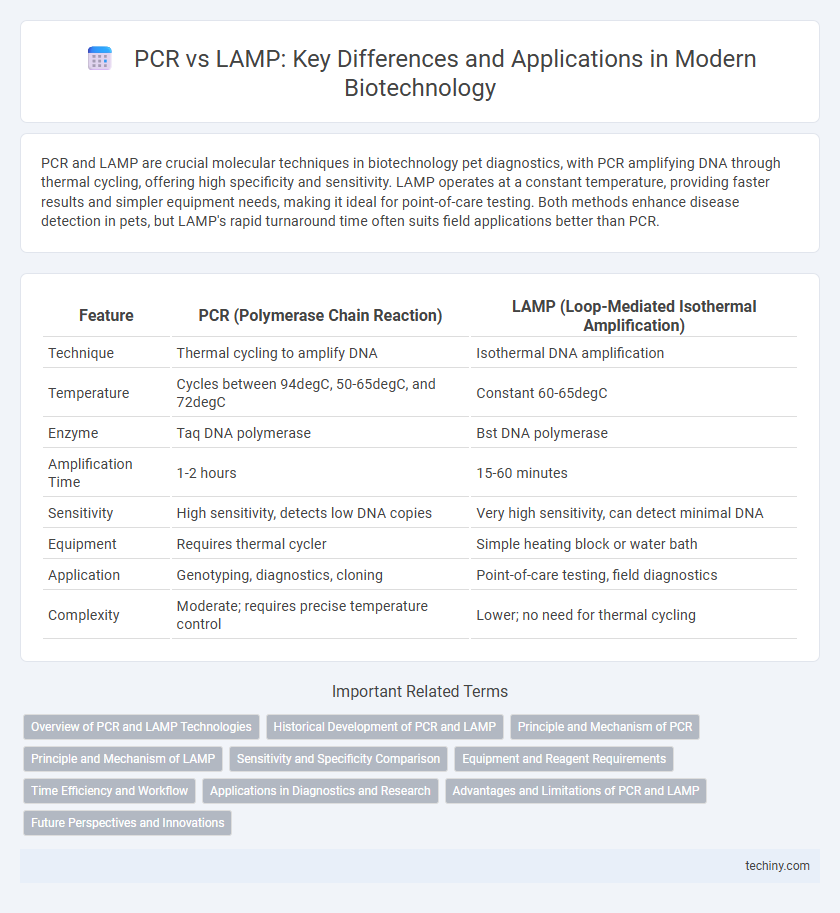PCR and LAMP are crucial molecular techniques in biotechnology pet diagnostics, with PCR amplifying DNA through thermal cycling, offering high specificity and sensitivity. LAMP operates at a constant temperature, providing faster results and simpler equipment needs, making it ideal for point-of-care testing. Both methods enhance disease detection in pets, but LAMP's rapid turnaround time often suits field applications better than PCR.
Table of Comparison
| Feature | PCR (Polymerase Chain Reaction) | LAMP (Loop-Mediated Isothermal Amplification) |
|---|---|---|
| Technique | Thermal cycling to amplify DNA | Isothermal DNA amplification |
| Temperature | Cycles between 94degC, 50-65degC, and 72degC | Constant 60-65degC |
| Enzyme | Taq DNA polymerase | Bst DNA polymerase |
| Amplification Time | 1-2 hours | 15-60 minutes |
| Sensitivity | High sensitivity, detects low DNA copies | Very high sensitivity, can detect minimal DNA |
| Equipment | Requires thermal cycler | Simple heating block or water bath |
| Application | Genotyping, diagnostics, cloning | Point-of-care testing, field diagnostics |
| Complexity | Moderate; requires precise temperature control | Lower; no need for thermal cycling |
Overview of PCR and LAMP Technologies
PCR (Polymerase Chain Reaction) amplifies DNA through thermal cycling, utilizing temperature changes to denature DNA, anneal primers, and extend new DNA strands with a thermostable DNA polymerase. LAMP (Loop-Mediated Isothermal Amplification) amplifies DNA at a constant temperature, leveraging a strand-displacing DNA polymerase and four to six primers that recognize distinct regions of the target sequence, enabling rapid amplification without thermal cycling. PCR is widely used for its specificity and quantitative capacity, while LAMP offers faster results and simpler equipment requirements, making it suitable for point-of-care diagnostics.
Historical Development of PCR and LAMP
The Polymerase Chain Reaction (PCR) was developed in 1983 by Kary Mullis and revolutionized molecular biology by enabling exponential amplification of DNA sequences through thermal cycling. Loop-Mediated Isothermal Amplification (LAMP), introduced by Notomi et al. in 2000, provides rapid DNA amplification at a constant temperature using a set of specially designed primers and a strand-displacing DNA polymerase. While PCR relies on temperature changes for denaturation and annealing, LAMP's isothermal process simplifies equipment requirements, accelerating nucleic acid detection in point-of-care diagnostics.
Principle and Mechanism of PCR
Polymerase Chain Reaction (PCR) amplifies DNA sequences through thermal cycling involving denaturation, annealing of primers, and extension by a DNA polymerase enzyme. The method relies on repeated temperature changes to separate DNA strands, allowing primers to bind and DNA polymerase to synthesize new strands from a template. PCR's principle enables precise exponential amplification of target DNA, contrasting with LAMP's isothermal amplification mechanism.
Principle and Mechanism of LAMP
Loop-mediated isothermal amplification (LAMP) amplifies DNA at a constant temperature of 60-65degC using a strand-displacing DNA polymerase and a set of four to six specially designed primers that recognize six to eight distinct regions of the target sequence. Unlike PCR, which requires thermal cycling, LAMP relies on the continuous strand displacement activity to rapidly generate large amounts of DNA with high specificity and efficiency. This isothermal amplification produces stem-loop structures and cauliflower-like DNA patterns through self-primed DNA synthesis, enabling faster and more robust detection of nucleic acids in clinical and environmental samples.
Sensitivity and Specificity Comparison
PCR exhibits high sensitivity and specificity due to its thermal cycling process that amplifies specific DNA sequences with precision. LAMP demonstrates comparable sensitivity but often surpasses PCR in specificity by using multiple primers recognizing distinct regions of the target DNA, minimizing false positives. Both techniques are powerful for pathogen detection, but LAMP's isothermal amplification allows for rapid results with strong specificity, making it advantageous in point-of-care settings.
Equipment and Reagent Requirements
PCR (Polymerase Chain Reaction) typically requires a thermal cycler for precise temperature cycling, while LAMP (Loop-mediated Isothermal Amplification) operates at a constant temperature using a simple heat block or water bath. PCR needs expensive reagents like thermostable DNA polymerase and fluorescent probes for real-time detection, whereas LAMP employs Bst DNA polymerase and multiple primers, reducing the cost and complexity of reagents. The minimal equipment and reagent requirements make LAMP more suitable for point-of-care diagnostics and field applications in biotechnology.
Time Efficiency and Workflow
PCR requires thermal cycling with precise temperature changes, making it time-consuming and dependent on sophisticated equipment, whereas LAMP operates at a constant temperature, significantly reducing amplification time to under an hour. The isothermal nature of LAMP simplifies the workflow, eliminating the need for thermal cyclers and allowing for faster, point-of-care diagnostics. These time efficiency and workflow advantages make LAMP particularly suitable for rapid, on-site detection in resource-limited settings.
Applications in Diagnostics and Research
PCR and LAMP are pivotal molecular techniques in biotechnology, each with unique applications in diagnostics and research. PCR offers high sensitivity and specificity for detecting genetic mutations, infectious agents, and forensic samples, making it a standard tool in clinical diagnostics and genetic research. LAMP provides rapid, cost-effective amplification under isothermal conditions, ideal for point-of-care testing, field diagnostics, and resource-limited settings, enhancing real-time disease surveillance and environmental monitoring.
Advantages and Limitations of PCR and LAMP
PCR offers high sensitivity and specificity for DNA amplification, making it ideal for detecting low-abundance genetic material, but requires thermal cycling and specialized equipment. LAMP provides rapid, isothermal amplification with minimal instrumentation, enabling point-of-care diagnostics, though it may have lower specificity and risk of non-specific amplification. Both techniques complement each other in biotechnology applications, with PCR excelling in precision and LAMP favoring speed and simplicity.
Future Perspectives and Innovations
Emerging innovations in PCR technology emphasize digital and microfluidic integration, enhancing speed, sensitivity, and quantification accuracy for point-of-care diagnostics. LAMP advancements focus on streamlined, isothermal amplification suitable for low-resource settings, with developments in multiplexing and lyophilized reagents to improve field usability and stability. Future perspectives highlight the convergence of both methods with AI-driven data analysis and portable devices to expand rapid pathogen detection and personalized medicine applications.
PCR vs LAMP Infographic

 techiny.com
techiny.com